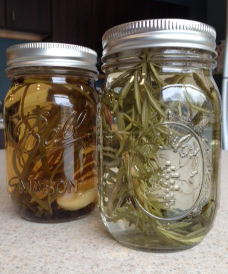Bulletin #4049, Let’s Preserve: Herbal Vinegar

By Kathleen Savoie, Extension Educator, University of Maine Cooperative Extension.
For information about UMaine Extension programs and resources, visit extension.umaine.edu.
Find more of our publications and books at extension.umaine.edu/publications/.
Herbal vinegar is vinegar infused with herbs, fruit or spices. These flavorful vinegars make great additions to salad dressings, fresh or sautéed vegetables, and make great gifts as well. To make herbal vinegars, you will need fresh herbs, vinegar, and canning jars. To ensure food safety, finished herbal vinegar must be refrigerated or needs to be heat processed in a boiling water bath.
Preparing the Vinegar
To start, select a type of vinegar to flavor. Any type of vinegar can be used, but some will compliment certain flavorings better. White vinegar is clear, but has a more acidic flavor, while cider vinegar, which is sweeter and milder, has an amber color. Wine and champagne vinegars are great, but are more expensive than other types. Balsamic vinegar is not recommended, because of its strong flavor.
Select fresh herbs, picked before blossoming, for best taste. Use two to three sprigs of herbs per pint (2 cups) of vinegar, and use only the tender stems and best leaves. Do not use leaves that are moldy, pest-damaged or discolored. Wash the herbs and dry on clean paper towels. After the herbs have dried, dip the herbs in a mild sanitizing solution (1/4 teaspoon germicidal bleach added to a pint of lukewarm water) for one minute. Rinse herbs thoroughly under cool, running water and pat dry with clean paper towels. Lay the dipped herbs on paper towels to dry or spin dry in a salad spinner.
If using spices, fruit or vegetables, such as garlic, jalapenos, berries, citrus peel, cinnamon, peppercorns or mustard seeds, wash well and use 1 to 2 cups of fruit per pint of vinegar and 1/2 teaspoon of whole spices per pint.
Sterilize your washed canning jars by boiling for 10 minutes in boiling water. Follow the manufacturer’s directions to prepare the lids.
Flavoring the Vinegar
Place your chosen fresh herbs, spices, fruits and/or vegetables in sterilized pint jars. Dried herbs may be substituted if necessary; allow 3 tablespoons dried herbs per pint of vinegar. Heat the vinegar to just below boiling (190-195°F). Pour vinegar over flavoring ingredients, leaving 1/4-inch headspace. Wipe the rims of the jars with a clean, damp cloth and screw on lids and screw bands.
Store vinegar at room temperature for 3 to 4 weeks to allow flavor to develop. You may taste the vinegar to gauge the flavor of the vinegar and allow it to develop for longer if needed. If the vinegar is too strongly flavored, you can dilute it by adding some plain vinegar.
Once the vinegar is flavored to your liking, you can strain the vinegar by pouring it through a coffee filter or damp cheesecloth and discard herbs. Pour strained vinegar into clean, sterilized jars. A washed and sanitized sprig of fresh herb may be added to the jar before closing.
To store your vinegar, refrigerate it and use within 3 months. For longer, shelf-stable storage, heat process the jars by processing pints for 10 minutes in a boiling water bath canner with 1/4-inch headspace.
If your flavored vinegar starts to mold at any time, or show signs of fermentation such as bubbling, cloudiness or sliminess, discard the product and do not use any of it that is left.
Suggested Herbal Pairings
Herbal-Mix Vinegar: Use 3 sprigs each of fresh rosemary, parsley, and thyme per pint jar of white or wine vinegar.
Fresh Tarragon Vinegar: Use 3 sprigs of fresh tarragon per pint jar of white or wine vinegar. Optional, add 1/3 cup minced fresh chives.
Lemon-Dill-Peppercorn Vinegar: Use the peel of one lemon (colored part only), 4 sprigs of fresh dill, and 1/2 teaspoon whole black peppercorns per pint jar of white or wine vinegar.
Spicy Parsley Vinegar: Use 3 sprigs of fresh parsley, 1/2 teaspoon of mustard seeds, and 1/2 teaspoon whole allspice per pint jar of white or wine vinegar. Also add 1/3 cup minced fresh chives.
Raspberry Vinegar: Use 2 cups of washed raspberries, lightly bruised with the back of a spoon, per 3 cups of white vinegar.
Information in this publication is provided purely for educational purposes. No responsibility is assumed for any problems associated with the use of products or services mentioned. No endorsement of products or companies is intended, nor is criticism of unnamed products or companies implied.
© 2014, 2023
Call 800.287.0274 (in Maine), or 207.581.3188, for information on publications and program offerings from University of Maine Cooperative Extension, or visit extension.umaine.edu.
In complying with the letter and spirit of applicable laws and pursuing its own goals of diversity, the University of Maine System does not discriminate on the grounds of race, color, religion, sex, sexual orientation, transgender status, gender, gender identity or expression, ethnicity, national origin, citizenship status, familial status, ancestry, age, disability physical or mental, genetic information, or veterans or military status in employment, education, and all other programs and activities. The University provides reasonable accommodations to qualified individuals with disabilities upon request. The following person has been designated to handle inquiries regarding non-discrimination policies: Director of Equal Opportunity, 5713 Chadbourne Hall, Room 412, University of Maine, Orono, ME 04469-5713, 207.581.1226, TTY 711 (Maine Relay System).

